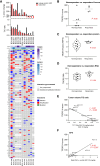Antitumor Activity and Biomarker Analysis for TROP2 Antibody-Drug Conjugate Datopotamab Deruxtecan in Patient-Derived Breast Cancer Xenograft Models
- PMID: 39585341
- PMCID: PMC11788653
- DOI: 10.1158/1078-0432.CCR-24-1948
Antitumor Activity and Biomarker Analysis for TROP2 Antibody-Drug Conjugate Datopotamab Deruxtecan in Patient-Derived Breast Cancer Xenograft Models
Abstract
Purpose: Datopotamab deruxtecan (Dato-DXd) is a humanized anti-trophoblast cell-surface antigen-2 (TROP2) IgG1 mAb linked to a potent topoisomerase I inhibitor payload (DXd). Dato-DXd has already shown antitumor activity in breast cancer; however, the determinants of response, including the importance of TROP2 expression, remain unclear. We tested the activity of Dato-DXd in a panel of breast cancer patient-derived xenografts (BCX) varying in TROP2 expression.
Experimental design: The antitumor activity of Dato-DXd and isotype-control-DXd (IgG-DXd) was assessed against 11 BCXs varying in TROP2 expression, 10 representing tumors postneoadjuvant chemotherapy. Pharmacodynamic effects were assessed at 24 and 72 hours. The effects of TROP2 expression on Dato-DXd activity was assessed in vitro and in vivo using viral overexpression in BCX-derived cell lines.
Results: Models differed in their sensitivity to both Dato-DXd and IgG-DXd. Dato-DXd (10 mg/kg) led to objective response in 4 (36%) models and statistically significant prolongation of event-free survival in 8 (73%) models, whereas IgG-DXd (10 mg/kg) led to response in 1 (9%) and prolonged event-free survival in 3 (27%) models. TROP2 RNA and protein were significantly higher in Dato-DXd-sensitive models. In isogenic cell lines derived from Dato-DXd-resistant BCXs, overexpression of TROP2 conferred Dato-DXd antitumor activity in vitro and in vivo. Dato-DXd increased γH2AX and phospho-KAP1 in the two Dato-DXd-sensitive BCXs but not in a Dato-DXd-resistant BCX. In Dato-DXd-sensitive models, antitumor activity was enhanced in combination with a PARP inhibitor, olaparib.
Conclusions: Dato-DXd is active in breast cancer models. Dato-DXd has TROP2-dependent and -independent mediators of activity; however, high TROP2 expression enhances Dato-DXd antitumor activity.
©2024 The Authors; Published by the American Association for Cancer Research.
Conflict of interest statement
F. Meric-Bernstam reports grants and personal fees from AstraZeneca and Daiichi Sankyo during the conduct of the study as well as personal fees from Becton Dickinson, Calibr (a division of Scripps Research), Dava Oncology, Debiopharm, EcoR1 Capital, eFFECTOR Therapeutics, Elevation Oncology, Exelixis, GT Aperion, Incyte, Jazz Pharmaceuticals, LegoChem Biosciences, Lengo Therapeutics, Menarini Group, Molecular Templates, Protai Bio, Ribometrix, Roche, Tallac Therapeutics, Tempus, Zymeworks, Biovica, Cybrexa, FogPharma, Guardant Health, Harbinger Health, Karyopharm Therapeutics, LOXO-Oncology, Mersana Therapeutics, OnCusp Therapeutics, Sanofi Pharmaceuticals, Seagen, Theratechnologies, and Zentalis Pharmaceuticals; grants from Jazz Pharmaceuticals, Zymeworks, Aileron Therapeutics, Inc., Bayer Healthcare Pharmaceutical, Calithera Biosciences Inc., Curis Inc., CytomX Therapeutics Inc., Debiopharm International, eFFECTOR Therapeutics, Genentech Inc., Guardant Health Inc., Klus Pharma, Takeda Pharmaceutical, Novartis, Puma Biotechnology Inc., and Taiho Pharmaceutical Co.; personal fees and other support from Dava Oncology; and other support from European Organization for Research and Treatment of Cancer (EORTC), European Society for Medical Oncology (ESMO), and Cholangiocarcinoma Foundation outside the submitted work. In addition, F. Meric-Bernstam has a patent for WO2023060283A2 pending. K.W. Evans reports grants from the NCI and other support from Daiichi Sanchyo during the conduct of the study. T. Maejima reports personal fees and nonfinancial support from Daiichi Sankyo, Inc./Daiichi Sankyo, Co., Ltd. during the conduct of the study and outside the submitted work. T. Karibe reports personal fees from Daiichi Sankyo Co., Ltd. during the conduct of the study and outside the submitted work. L.A. Byers reports personal fees from AstraZeneca and Daiichi Sankyo outside the submitted work. D. Okajima reports personal fees from Daiichi Sankyo Co., Ltd. during the conduct of the study and outside the submitted work; in addition, D. Okajima has a patent for “Anti-TROP2 antibody–drug conjugate” issued to Daiichi Sankyo Co., Ltd. S. Damodaran reports grants from Guardant Health, Taiho Pharmaceuticals, Novartis, Serono, Sermonix, AstraZeneca, and Medilink outside the submitted work. No disclosures were reported by the other authors.
Figures






References
-
- Nelson BE, Meric-Bernstam F. Leveraging TROP2 antibody-drug conjugates in solid tumors. Annu Rev Med 2024;75:31–48. - PubMed
-
- Shimizu T, Sands J, Yoh K, Spira A, Garon EB, Kitazono S, et al. . First-in-human, phase I dose-escalation and dose-expansion study of Trophoblast cell-surface antigen 2-directed antibody-drug conjugate datopotamab deruxtecan in non-small-cell lung cancer: TROPION-PanTumor01. J Clin Oncol 2023;41:4678–87. - PMC - PubMed
-
- Bardia A, Jhaveri K, Im SA, Pernas S, De Laurentiis M, Wang S, et al. . LBA11 Datopotamab deruxtecan (Dato-DXd) vs chemotherapy in previously-treated inoperable or metastatic hormone receptor-positive, HER2-negative (HR+/HER2–) breast cancer (BC): primary results from the randomised phase III TROPION-Breast01 trial. Ann Oncol 2023;34:S1264–5.
MeSH terms
Substances
Grants and funding
LinkOut - more resources
Full Text Sources
Medical
Research Materials
Miscellaneous

